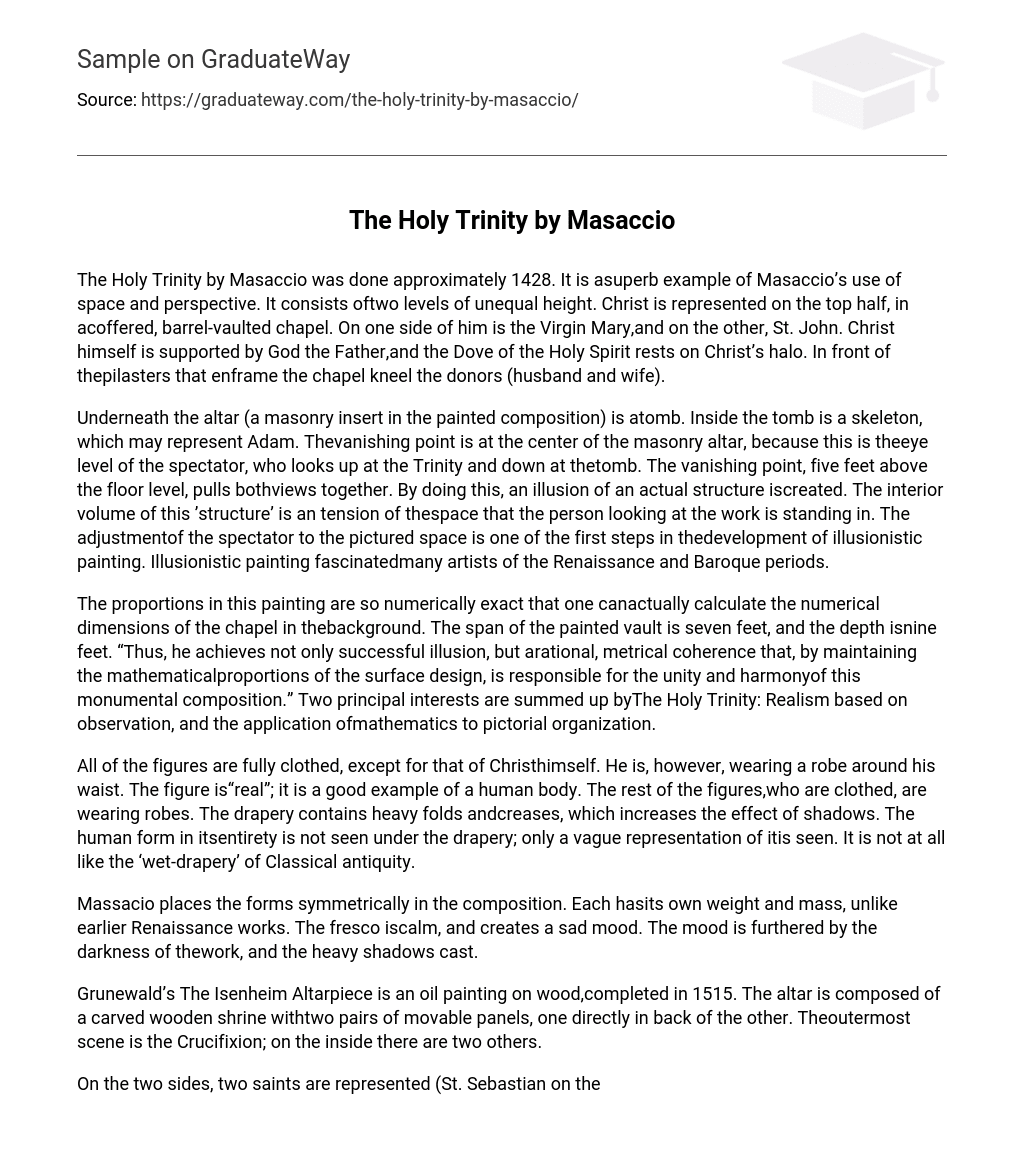The Holy Trinity by Masaccio was done approximately 1428. It is asuperb example of Masaccio’s use of space and perspective. It consists oftwo levels of unequal height. Christ is represented on the top half, in acoffered, barrel-vaulted chapel. On one side of him is the Virgin Mary,and on the other, St. John. Christ himself is supported by God the Father,and the Dove of the Holy Spirit rests on Christ’s halo. In front of thepilasters that enframe the chapel kneel the donors (husband and wife).
Underneath the altar (a masonry insert in the painted composition) is atomb. Inside the tomb is a skeleton, which may represent Adam. Thevanishing point is at the center of the masonry altar, because this is theeye level of the spectator, who looks up at the Trinity and down at thetomb. The vanishing point, five feet above the floor level, pulls bothviews together. By doing this, an illusion of an actual structure iscreated. The interior volume of this ’structure’ is an tension of thespace that the person looking at the work is standing in. The adjustmentof the spectator to the pictured space is one of the first steps in thedevelopment of illusionistic painting. Illusionistic painting fascinatedmany artists of the Renaissance and Baroque periods.
The proportions in this painting are so numerically exact that one canactually calculate the numerical dimensions of the chapel in thebackground. The span of the painted vault is seven feet, and the depth isnine feet. “Thus, he achieves not only successful illusion, but arational, metrical coherence that, by maintaining the mathematicalproportions of the surface design, is responsible for the unity and harmonyof this monumental composition.” Two principal interests are summed up byThe Holy Trinity: Realism based on observation, and the application ofmathematics to pictorial organization.
All of the figures are fully clothed, except for that of Christhimself. He is, however, wearing a robe around his waist. The figure is“real”; it is a good example of a human body. The rest of the figures,who are clothed, are wearing robes. The drapery contains heavy folds andcreases, which increases the effect of shadows. The human form in itsentirety is not seen under the drapery; only a vague representation of itis seen. It is not at all like the ‘wet-drapery’ of Classical antiquity.
Massacio places the forms symmetrically in the composition. Each hasits own weight and mass, unlike earlier Renaissance works. The fresco iscalm, and creates a sad mood. The mood is furthered by the darkness of thework, and the heavy shadows cast.
Grunewald’s The Isenheim Altarpiece is an oil painting on wood,completed in 1515. The altar is composed of a carved wooden shrine withtwo pairs of movable panels, one directly in back of the other. Theoutermost scene is the Crucifixion; on the inside there are two others.
On the two sides, two saints are represented (St. Sebastian on the left,and St. Anthony on the right). Together, these saints established thetheme of disease and healing that is reinforced by the inner paintings. Onthe bottom of the panel, when opened, it appears that Christ’s legs wereamputated; possibly an allusion to ergotism, a disease treated in thehospital where the altarpiece was kept.
An image of the terrible suffering of Christ is in the middle. Thesuffering body hangs against the dark background, which falls all the wayto the earth. The flesh is discolored by decomposition and is studded withthe thorns of the lash. His blackening feet twist in agony, as do hisarms. His head is to one side, and his fingers appear as crooked spikes.
The shuddering tautness of Christ’s nerves is expressed through thepositions of his fingers. Up to this point, no other artist has everproduced such an image of pain. The sharp, angular shapes of anguishappear in the figures of the swooning Virgin and St. John, and in theshrill delirium of the Magdalene. On the other side, John the Baptist, agaunt form, points a finger at the body of the dead Christ. Even thoughdeath and suffering are dominant in the altarpiece, there are symbols ofhope: The river behind St. John, which represents baptism, and thewine-red sky which symbolizes the blood of Christ. Through these bols, ahope of salvation is offered to the viewer.
The use of space is ambiguous in some places: All of the forms are atthe same general depth in the painting. However, none of the forms aretangled, or intertwining. Therefore, the space is not badly used.
Once again, all of the forms except for that of Christ are fullyclothed. Christ is again wearing a small robe around his waist. The otherforms are depicted superbly. Their bodies are not lost behind the draperywhich they wear, yet they are not seen exactly either. The folds are moredelicate, which create a calmer mood. (Christ’s description was alreadygiven). The forms are three dimensional, and also have weight. Theyclearly take up space, and where they are is clearly defined.
As in The Holy Trinity, the composition is generally symmetrical,centered around the body of Christ. It is a frightful composition,because of the events taking place. Expression is shown on all of thefigures, who grieve Christ’s death.
Overall, the two works are very similar. Masaccio, however, was moreinterested in the mathematical aspects of painting than Grunewald. Bothworks are superb, and have their own distinct qualities.





